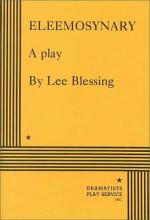|
This section contains 228 words (approx. 1 page at 400 words per page) |

|
Eleemosynary Summary & Study Guide Description
Eleemosynary Summary & Study Guide includes comprehensive information and analysis to help you understand the book. This study guide contains the following sections:
This detailed literature summary also contains Bibliography and a Free Quiz on Eleemosynary by Lee Blessing.
Lee Blessing often focuses on family dynamics in his plays. Eleemosynary, one of his most acclaimed works, is no exception. The play was first performed in Minneapolis, Minnesota, in 1985 and published by the Dramatists Play Service in 1987; it forms part of the collection Four Plays, published by Heinemann in 1991. Eleemosynary won the prestigious Los Angeles Drama Critics Circle Award in 1997 for its penetrating study of the interactions among three members of the Wesbrook family. In his examination of their relationships with one another, Blessing illustrates the tensions that can stress a family to its breaking point.
Eleemosynary focuses on the lives of three Wesbrook women: seventy-five-year-old Dorothea; her middle-aged daughter, Artie; and Artie's sixteen-year-old daughter, Echo. Dorothea, an admitted New Age eccentric, has complicated the lives of the two other Wesbrook women by imposing her thwarted dreams on them, which has alienated Artie not only from Dorothea but from Echo as well. As the play begins, Echo is caring for Dorothea, who has just had a stroke. During the course of the play, Echo tries to bring the three women together. Blessing presents fragmented vignettes of the lives of the three women as they struggle to define themselves both as individuals and as part of a family unit. In this poignant and mature study of familial relationships, Blessing highlights the human need for connection and forgiveness.
Read more from the Study Guide
|
This section contains 228 words (approx. 1 page at 400 words per page) |

|



